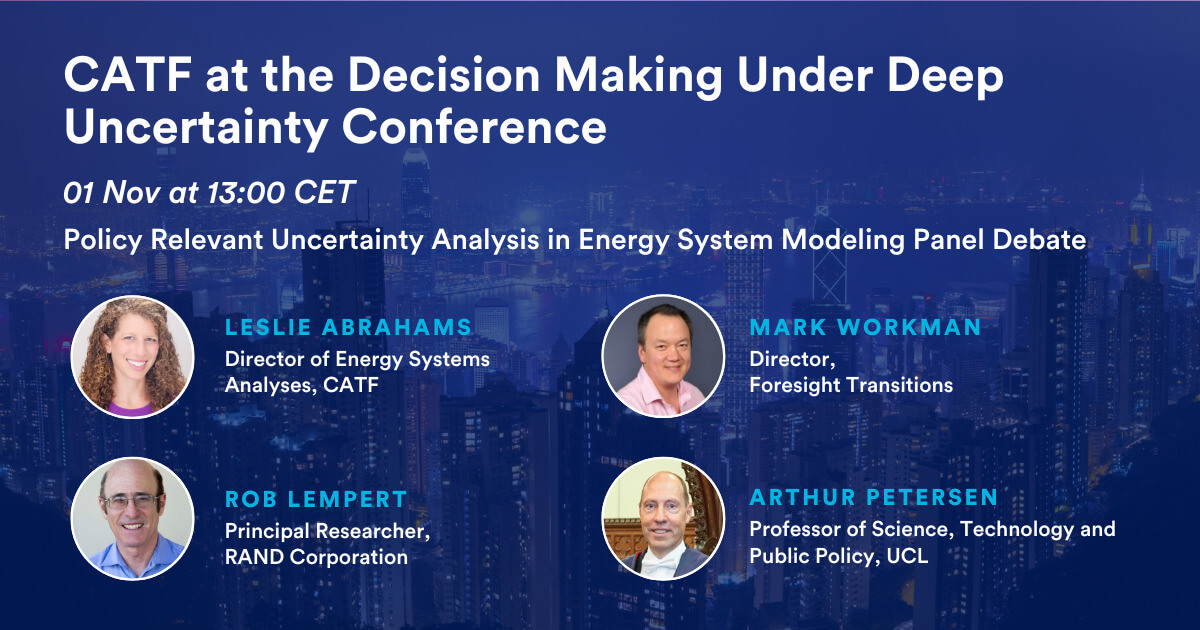
The need for deep uncertainty analysis in energy policy and planning
Transitioning to a decarbonized energy system to meet climate targets requires enormous political will and billions of dollars in investments in technological transformation and infrastructure deployment. These policies and investments to decarbonize our energy system must be made today despite the many unknowns about how the future may unfold. Critically, what makes decisions around the energy transition different from many other uncertain political contexts is that not only are we unsure about the future, but we do not have any information about the probabilities of possible outcomes. In fact, even the full range of possible outcomes is unknowable. This concept of making decisions with this degree of unknowns about the scope of future states is referred to as decision making under deep uncertainty (DMDU). Policy- and decision-making aimed at decarbonizing the energy system is faced with the challenge of the highest level of DMDU (“level 5”, Figure 1).

DMDU in the energy transition must be recognized and appropriately addressed to maximize the likelihood of successful energy policies and investments that have a robust range of future outcomes and are adaptable as the transition progresses. Especially challenging are the facts that:
- The uncertainties are irreducible. They cannot be meaningfully minimized with additional research or knowledge.
- There are a variety of stakeholders, often with different perspectives on what constitutes the system, what problems need to be solved, and which priorities and values should be applied to a decision-making context.
- Investment decisions tend to have long-term consequences, and wrong decisions are particularly costly and detrimental to our ability to meet near-term climate targets.
- Decisions must be made under time pressure due to the urgency of mitigating emissions to avoid the worst impacts of climate change.
- The energy transition is a problem we must solve at the nexus of multiple complex systems. The trajectory of a transition will be determined by complex interactions and interdependencies between economic, technological, political, and environmental conditions.
Energy system modeling is an important tool that provides guidance to policy makers about possible future pathways to inform policies and decision making. The problem is, many approaches to energy modeling over-simplify uncertainty, thereby resulting in over-confidence in the robustness of the policy decisions they support. Standard techniques, such as cost-optimization, presume a degree of knowable uncertainty and a single agreed upon measure of ‘goodness’. In this case, deterministic assumptions are made about all system parameters (such as levelized cost of energy, demand trajectories, EV adoption, etc.) and the presumed prioritized value is total system cost. This is referred to as a “predict then act” approach, where future conditions are assumed, ideal near-term decisions are projected, and scenarios are used to assess a range of conditions (Figure 2). While this is a useful tool to help make decisions under more simple uncertainty contexts, this approach breaks down under conditions of deep uncertainty.

To better understand the mismatch between “predict then act” methods and the energy transition policy realm, we can consider Figure 3, which is a representation of the range of uncertainty levels characterized, paired with an increasing range of stakeholder value complexity on the y-axis. Traditional energy transition models described above typically are single-objective optimization models (e.g., cost minimization). More advanced models consider multi-objective optimization that may attempt to balance additional considerations, such as land-use or cumulative emissions. However, even multi-objective optimization models fail to capture the realities of the value of diversity in energy transition planning. Furthermore, the deterministic input assumptions in the model assume a level of knowledge of how technologies and economics will progress. In figure 3, these two characterizations of this analytical approach (accounting for limited values and minimal uncertainty) fall within the red rectangle. In contrast, the green rectangle in Figure 3 represents the true nature of the energy transition problem. Decarbonization policy is inherently deeply uncertain and is comprised of extensive and diverse values criteria (i.e., cost, energy demand, etc.). Yet, the analytical approaches typically employed to inform policy and investment decisions – represented by the red rectangle – do not meet the complex nature of this realm. By relying on analytical approaches that do not meet the needs of policy issues in the green rectangle, our energy decarbonization planning is vulnerable to future conditions instead of being robust and adaptable over time.

There are quantitative methods that support the types of decisions that fall within the green rectangle. Incorporating these DMDU methods into energy analysis is critical to appropriately representing the complexity and inherent unknowability of our decarbonization trajectory. However, the process of DMDU analysis is often complex, specialized, and limited to a select group of experts, which can silo the important information gained by such an analysis within a theoretical realm, leaving policy makers in the dark and imbuing a sense of overconfidence in their policy positions. Despite advances within the literature of new methods and applications of DMDU to this field, most policy decisions remain informed by deterministic models run under a limited set of scenarios. We need to change this energy analysis paradigm and instead strive to identify transparent, impactful, and timely means of infusing decision-relevant deep uncertainty into the policy realm.
The Energy Systems Analysis program at Clean Air Task Force led a panel discussion at the 2023 Society for Decision Making Under Deep Uncertainty annual meeting in Delft focused on just this topic; how to transfer academic approaches to DMDU to applied energy policy decision-making contexts. The panel convened experts at the intersection of technical analysis and policy to discuss the challenges and barriers of translating uncertainty to inform policy decisions and how these may be addressed. The discussion delved into five topics:
- Limitations preventing deep uncertainty analysis from being consistently applied within a policy context.
- Development of user-friendly tools, guidelines, and frameworks that enable non-experts to perform meaningful uncertainty assessments.
- Collaborative approaches in uncertainty analysis, involving diverse stakeholders such as researchers, policymakers, industry representatives, and local communities.
- Effective communication strategies for uncertainty analysis results, ensuring clear and concise messaging that is understandable to policymakers, stakeholders, and the general public.
- Developing capacity to empower a wider range of individuals and organizations in conducting deep uncertainty analysis.

Three key challenges emerged from the panel discussion as barriers to incorporating DMDU analytical approaches into the applied energy policy realm:
- Timeline – DMDU approaches often are computationally intensive and historically have not been able to support the pace of energy policy discussions and negotiations.
- Complexity – DMDU approaches typically lead to dynamic and complex outputs that involve many scenarios, caveats, and trade-offs. This can be much more overwhelming to stakeholders than the single point predictions from deterministic models that can feel more approachable and actionable.
- Political dynamics – Politicians appear stronger, more believable, and confident when they project or indicate certainty than when accurately representing the unknown nature and complexities of a problem.
The Energy Systems Analysis (ESA) team at CATF is committed to supporting analytical approaches that provide our policy makers with informed, objective, and transparent guidance about policies and approaches to decarbonization. As policy analysis practitioners with expertise in the theory of DMDU, it is our role to help bridge this gap between academic methods and applied decision making. ESA will continue to partner with academics, practitioners, advocates, and policy makers to bring together this diverse set of stakeholders to work together to address the barriers and challenges preventing DMDU techniques being applied to energy system decarbonization planning.





